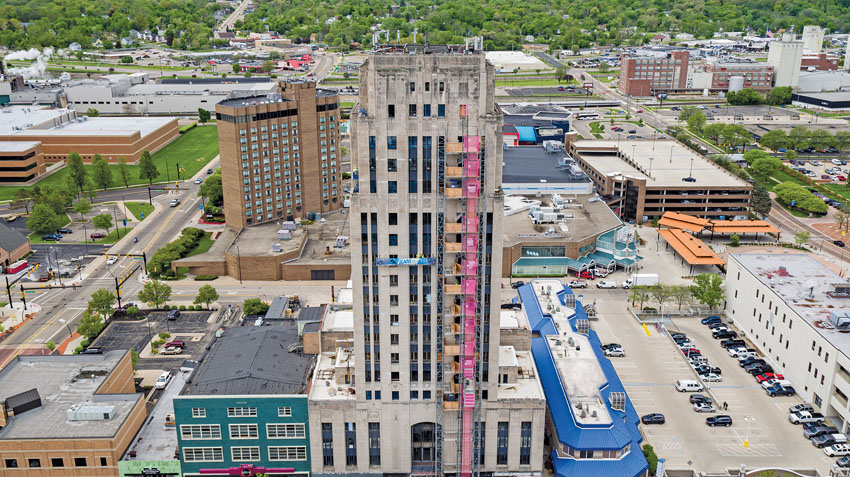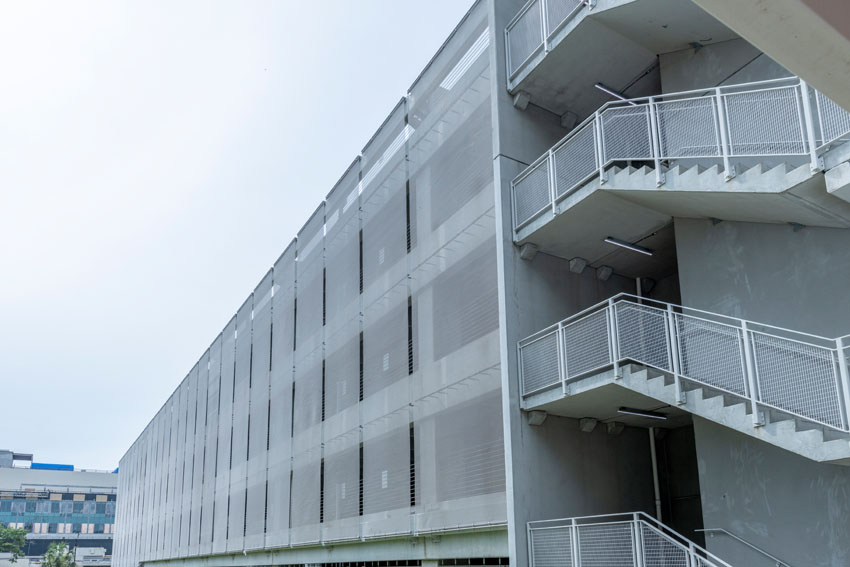Choices Abound for Attractive & Smart Facade Design
More Than Just Window Dressing
Materials used in historic high-rise buildings were primarily single-pane glass, wood, galvanized steel, and iron. During restoration projects, updating the windows while maintaining the aesthetic of vintage facades is mission critical. Each building is unique, and the potential impact of energy-savings with windows and proper installation can be significant. Fortunately, sustainable products, methods and high-performance properties in modern windows are available to preserve the look of treasured history while providing thermal efficiency, comfort, and protection against facades exposed to weathering in extreme climates and conditions.
In regions subject to catastrophic events caused by nature or humans—earthquakes, blasts, or hurricanes—materials must remain very strong to withstand multiple adverse forces and the ravages of time. When specifying to address such events, understanding and utilizing modern window components can greatly improve the durability of projects. Aluminum thermal-barrier windows, for instance, offer higher performance in impact resistance, shear strength, and heat distortion than other materials and methods.
At the core of aluminum thermal barrier is a manufacturing process called pour and debridge, a highly efficient technology used to create the framing material, that incorporates a non-metallic polymer component. The role of pour-and-debridge polymer thermal barriers in aluminum is to interrupt the flow of energy through the metal and provide exemplary structural strength in the facade. The technology that is used to enhance custom-made vintage windows is also used by manufacturers of curtain walls, windows, storefronts, doors, and skylights.
To create an aluminum thermal barrier window, the aluminum profile is extruded with a strategically placed channel to encapsulate an insulating polymer. The channel surface is conditioned with special equipment to create a “mechanical lock,” and then a two-part polymer is dispensed into the channel as a liquid. This is the “pour” part of the process. As the liquid hardens, it creates a durable, structural insulating element on top of the aluminum. Once the polymer is set, the bottom of the metal channel is removed, leaving just the polymer. This is the “debridge” part of the manufacturing process. With the aluminum metal-to-metal connection broken, conductive heat transfer through the frame is greatly reduced, thus resulting in a highly energy-efficient frame with remarkable structural strength.
Companies that specialize in window restoration and installation of historic replication material are challenged to provide products that match original aesthetics, while providing optimal thermal efficiency.
Preserving the Image of Battle Creek
One project that serves as an example of how to incorporate new fenestration technologies into vintage facades is The Milton, a mixed-use redevelopment project in downtown Battle Creek, Michigan. The Milton luxury apartments are combined with retail and business space. Constructed in 1931 as the Old Merchants National Bank, the building is listed in the National Register of Historic Places and is one of the last projects designed by Chicago architectural firm Weary and Alford. The repurposing of the 19-floor historic downtown high-rise building proved a challenge from both a preservation of historic properties and an extreme climate standpoint. All of Michigan is located in a climate zone exposed to extreme weather conditions—Battle Creek averages 53 inches of snowfall annually— so facade materials must be thermally efficient against harsh northern winters. The warm season lasts for 3.8 months from May to September, when temperatures in the city will average 75 degrees Fahrenheit and will reach 95 degrees Fahrenheit or greater on the hottest days.

Photo: Taylor Kallio, Kalamazoo Aerial Media
The Milton in Battle Creek, Michigan, required windows that met both historic preservation requirements and extreme weather demands.
Kate Shields, a project estimator with glazing contractor Blackberry Systems in Kalamazoo, Michigan, worked on the project. She says, “The Milton has been one of our most comprehensive restoration and replication projects that we have undertaken in the past 30 years. The 90-year-old project required us to not only restore historic metals, decorative skylights, and the original historic storefront, but the steel windows also had to be completely replaced due to the poor condition they were in. The original steel windows had a unique design of a two-lite casement over a lower fixed transom with narrow stile sightlines, posing a challenge to replicate.”
Working directly with the manufacturer, Shields was able to develop a design detail that matched the sightlines and profiles within the 1/8-inch tolerance required by the National Park Service historic preservation standards for the treatment of historic properties. She says, “To accomplish this, we used a custom panning. Structural and thermal performance were important as well due to the height of the building and exposure to the elements in Michigan. Our experience working on large high-rise buildings such as The Book Tower and 600 Vinton Building in Detroit helped prepare us for the challenges we faced here in downtown Battle Creek.”
Using structural aluminum fenestration materials with polyurethane polymer thermal barriers, the final installation was able to optimize energy savings, increase comfort, and lower operational costs. The custom thermal-barrier window glazing consists of 1-inch insulating glass with double-silver, low-emmisivity (low-e), argon-filled, warm edge spacers that provide a U-factor of 0.30 for high energy efficiency, comfort, and protection when the weather and temperatures are extremely cold or hot.
Shading and Protection
Balancing the needs for beauty with the functional needs for energy savings, protection from the elements, and comfort of occupants is not always an easy task, especially in exterior facade applications like parking garages and walkways. These areas leave visitors and their vehicles exposed to whatever Mother Nature can dish out, be it extreme heat, hurricane-driven rain, or frozen winters.
For areas where both solar gain and wind-driven moisture are an issue, coiled wire fabric can be a protective solution. The coiled wire, unlike standard mesh, provides an element of shade that most standard facade elements cannot. However, coiled wire fabrics also offer a level of translucency that delivers a simultaneously open and closed feel.
As a parking-garage facade, coiled wire fabric panels provide an added layer of weather protection for vehicles and occupants inside. In the winter months, less rain, snow, and water are able to enter a structure, resulting in less of a chance for ice accumulation when temperatures drop below freezing. Not only is this a benefit to garage users, but building owners are also at less risk for legal action, and building maintenance staff are less likely to have to spread road salt on the interior of the garage. By reducing the amount of snow or water that enters the garage, these structures do not experience as much wear and tear from winter weather maintenance, and drivers and pedestrians have a safer environment to navigate.
Protecting Patients in the Big Easy
When looking for a solution to help protect patients, visitors, and employees at the recently renovated Children’s Hospital New Orleans, architect EYP Architecture and Engineering selected coiled wire fabric on the facade. The $300-million multiphase campus transformation was slated to include a new skybridge, exterior renovations to sections of the hospital’s facade, new additions to accommodate more beds and emergency rooms, and a 600-car (244,340-square-foot) parking garage. Finding a facade material to help maintain ventilation while also providing protection from the elements was a critical component of the design process.

Photo courtesy of Cascade Architectural
Coiled wire fabric was specified for the exterior of the Children’s Hospital New Orleans to reduce exposure to elements like extreme sun and rain while also providing fall protection and ventilation.
Moses Waindi, senior project architect at EYP Architecture and Engineering, explains that the coiled wire fabric system was a fashionable fit for the project. “Coiled wire fabric presented a more cost-effective solution to wrapping the garage in metal mesh, and we also just preferred the inherent coiled design over other products.”
The five-story parking garage features 40 panels of 3/8-inch, 14-gauge coiled wire fabric in 316 stainless steel, which exhibits the highest level of corrosion resistance amongst all types of stainless steel. The panels run parallel vertically from the second story to the fifth, with smaller individual sections of coiled wire fabric spanning the perimeter of the ground level.
Coiled wire fabric facades impart a higher degree of aesthetic value compared to traditional garages that are strictly made up of structural metal and concrete. This was especially vital at the Children’s Hospital New Orleans, where a friendly and welcoming atmosphere holds a greater deal of importance.
Functionally, the coiled wire fabric provides natural ventilation so that air can flow freely throughout and car fumes are not trapped within the structure. The panels also protect against rain, snow, and sun, effectively working to keep occupants more comfortable while walking from car to hospital and back. As an added safety precaution, the durable tensioned panels secure the structure’s perimeter, providing fall protection for anyone walking or parked near the outer edge of the garage.
Notice

www.azonintl.com

www.cascade-architectural.com

www.inpro.com

www.vitroglazings.com/solarban









